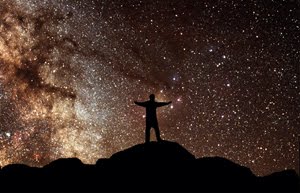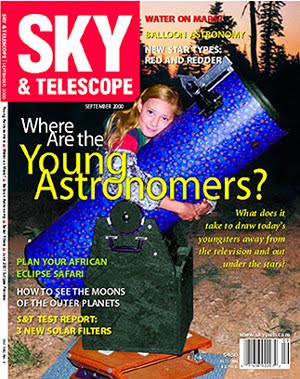I had an excellent time at this year's CalStar. Conditions really couldn't have been much better. For those of you who were late arrivals, change your plans next year to be there all three nights - Thursday was the hands-down winner for observing conditions. I know a few "can't get enough" types arrived early, maybe their conditions were better, but about the only way I could imagine that being possible is if there were eyepiece bearers to swap my Naglers and maybe a regular flow of pizza being delivered on site!
Before getting into the specifics, I want to extend a general "great job done" to Rob Hawley, Mike Koop and the San Jose Astronomical Association. I can tell you all firsthand that the job of organizing CalStar is time consuming and carries some modest financial risk for the club - and we owe these people a debt of gratitude for their efforts.
So, the highlights....
Seeing the following people make the journey...
- James Turley
- Tom Osypowski and Nan
- Jeff Gortatowksi
- Paul Sterngold
- Michelle Stone
- John Bunyon
All folks who I don't get to see often enough.
Sampling good single malts with Steve Sergeant was a last night highlight.
Kevin scrounging for an air pump in the middle of the night.
His brother Kevin delivering Sharks tickets to me on site.
Heather trying to find a tough object in my 18, with the Quickfinder half a degree off!
Jane Smith wine tasting under her double canopy surrounded by friends.
Rashad reacting to the dust cloud!
Friday night's potluck at Uncle Dan's Country Kitchen.
The buzz of a hundred voices outside in the dark when I woke from an after dinner nap Friday night.
It was a great experience, shared among many friends.
As for observing, I spent much of my time in Lacerta, just going through a printed list of objects catalogued in the Saguaro Astronomy Club deepsky database. It was fun, starting with (now, try to control your excitement) stellar planetaries. Gortatowski and I worked these.... you'd find the star field and swap in an OIII filter to make the planetary stand out. Yes, it was fun. There were also a good number of galaxy groups we ran into. This, by the way, was all interspersed with visits from friends and sipping Mexican Coffee (which is why I think they were visiting!).
The best views of the trip though had to be between 4 and 5 a.m. Friday morning. Lacerta was setting, I was tired, so I decided to just look at some bright stuff. Orion was riding high, and I'd heard someone mention the Flame Nebula. I pulled out a new filter Dan McShane of DGM Optics sent me. I knew nothing about it, other than last year he'd sent me the VHT (very high transmission) filter he was manufacturing. Dan is a long time acquaintance. The VHT had been my favorite filter for the Veil and the bright summer nebulae. But I didn't even know what the new one (the NPB) was called, or what it did. The filter arrived via UPS as I was pulling out of the driveway to head to LSA. I looked at the Flame without the filter and thought it was obvious enough that we might have a good night for the Horsehead. On went the filter, but the Flame did not show much improvement. I thought "okay.... I'll experiment on different objects to see what this is good on"...
It did nothing for the Horsehead, but I do feel it was effective in showing IC 434. I only saw a dark area where the Horsehead should be, there was not detail - just a void.
I kept the NPB filter on and swung the scope to M42. When I looked in the eyepiece I was off by over a degree, but there, subtly in the field, I saw all sorts of thin veils of nebulosity with dark lanes and blobs. I wondered where I was... and noticed it getting brighter as the field drifted. I was on the extreme outskirts of the western edge of the nebula. I let it drift. What a sweet view.... slowly the entire nebula drifted through. The NPB filter brought out details I've never seen. This was certainly one of the greatest views I've had of M42. The view seemed to take on a three dimensional feel, especially around the eastern wing and behind the Trapezium to M43. I also found the Running Man to be spectacular that night - nebulosity surrounding the bright stars like the photos we love of the Merope Nebula in the Pleiades. What a great night!
Happy with the results on M42, I thought this was an OIII type filter, and immediately hopped over to NGC 2392, The Eskimo Nebula in Gemini.
Wow! What a view! I put in the 7 Nagler with an 1.25" PMB filter and had a truly Hubble-like view. Seriously, there was such wonderful detail and nice natural looking coloration I could hardly believe it. I started looking around to call friends over, and realized it was just me and a few snoozing imagers left standing (or, wobbling). I looked again. The planetary's central star was bright and sharp. A black donut surrounded it. Around the blackness was a searing green disk with sharply defined inner and outer edges. The bright ring seemed uneven in places, as if there were areas of filament and areas of void in it. At the outer edge of the bright ring began an almost spongy looking ring - or maybe I should call it "gausey" looking - it was definitely thinner and dimmer - but what got me was the amount of fine detail and that wonderful greenish glow. The view was close to this, really, but without the red - just a nice bright green inner ring and more muted green outer shell....
http://www.noao.edu/outreach/aop/observers/n2392kempton.jpg
As far as I was concerned, the two views, M42 and the Eskimo, made it a great trip.
Oh, I finally did find out a bit about the filter - people at CalStar were having a good laugh when asking what it was called and what it did, and I couldn't answer. Here's some info:
http://users.erols.com/dgmoptics/LPRfilters.htm
FWIW, some of us began calling it the 3D filter. Not a bad name for it!
Again, thanks to Mike and Rob, and all who attended and made it so much fun....











